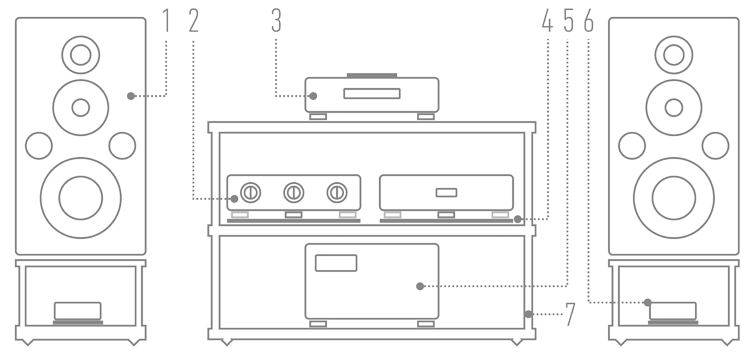|
POWER AMPLIFIER • stereo AUDIO PHONIQUE
Manufacturer: AUDIO PHONIQUE |

|
Review
text WOJCIECH PACUŁA |

|
No 257 October 1, 2025 |
|
˻ PREMIERE ˼ ⌈ AUDIO PHONIQUE is a Polish company founded in 2018 by two enthusiasts, MACIEJ LENAR and WOJCIECH MURAWIEC. However, it was not until 2022 that it unveiled its complete range – twelve products at once. We are testing the Classic 300D power amplifier for the first time, offering a staggering 300 W at 8 Ω and 600 W at 4 Ω. ⌋ MORE AND MORE OFTEN IN E-MAILS sent by you to the editors, alongside the price and other basic information, there is a statement: “it shouldn't get too hot.” This, of course, refers to amplifiers. In the context of the Accuphase E-800S reviewed here last month, which delivers 50 W in class A at 8 Ω and as much as 200 W at 2 Ω, and is one of the best devices of its kind on the market, such a request may seem out of place. After all, we are talking about high-end equipment and reading about it in a magazine that has grown out of an audiophile ethos. So, what is the reality? 
If we approach the issue ideologically, then indeed – such requests are inappropriate. They show that sound is not a value in itself for us, that we are not fighting with all our might for the highest quality, and that we allow ourselves to think about “betrayal.” The thing is, ideology always serves someone or something, and never us, ordinary people. Audio, as I have been trying to tell everyone for years, is something much greater than sound itself. It is a kind of an ecosystem in which sound, craftsmanship, aesthetics, haptics, ergonomics, and even packaging are important. It is a product, not a device (cables, speakers, etc.). That's why I like answering questions like this, because they show that the person asking them is someone who is aware of their needs, someone who chooses products with a clear idea in mind. If a hypothetical reader said, “Screw heating, it's only the sound that matters,” that would be great too – they would also be clear about their choices. It is important that we have this choice. And the Audio Phonique 300D power amplifier from the Classic series gives us that. ▲ A few simple words with… MACIEJ LENAR 
OBSERVING THE DEVELOPMENT OF CLASS D TECHNOLOGY in recent years, we can say with complete confidence that it has reached a level that allows us to create designs with sound that is not only precise, but also musical and engaging. Our goal was precisely this approach – to break with previous associations with Class D and present a device that combines technical sophistication with high-quality sound. In the 300D model, we have not only used a refined topology but also placed great emphasis on the quality of passive components and the tuning of the entire unit. It is these elements – often underestimated – that determine the final character of the sound in our approach. The design process involved long listening sessions, verification of tonal microdetails and spectral analysis of harmonics. We strive to ensure that the device not only “does well" in tests, but above all sounds the way our demanding ears expect it to. 
The Audio Phonique 300D offers high output power, impressive current efficiency and a damping factor of 300, which translates into excellent driver control – especially in the low frequency range. Distortion remains a key factor: not only its absolute level, but also its distribution characteristics – tailored to human hearing perception, in accordance with the psychoacoustic principles of harmonic audibility. The amplifier can be successfully controlled directly from a source equipped with volume control, but for maximum control and full use of its capabilities, we recommend integration with a high-end line preamplifier. ML ▌ The Classic 300D The CLASSIC SERIES in the Audio Phonique nomenclature refers to devices equipped with classic powder-coated steel enclosures. In contrast, the Statement Line series uses high-gloss polished stainless steel. Classic also has fronts that we are used to seeing in audio equipment, i.e., made of aluminum. They are trimmed at the bottom and top, which gives a nice visual effect. In the center, there is a large laser-cut company logo illuminated by white LEDs. We are testing one of six devices available in the Classic series. It is a stereo power amplifier offering as much as 600 W – the manufacturer does not specify the impedance, but I assume it is 4 Ω. The device itself is small – it measures 365 x 450 x 112 mm and weighs 11 kg. As you might guess, this is possible thanks to the use of class D power amplifiers. This means efficiency exceeding 90% and, consequently, minimal heat emission. 
So, this would be one of the options I would present to the reader mentioned at the beginning, who cares about the environment or electricity bills (or both), or about well-being – it doesn't matter what the impulse was, the decision is what matters. You can read more about class D in Wojtek Kotarba's article entitled Klasa D – po co to komu? → HERE ˻PL˺. We can read the following about the tested product:
You have probably (definitely) noticed the symbol in the name of the device. It's a cool idea from the company, a really cool one, to speak of... Although this combination appeared once before in a product from Simaudio Moon, it was a 300D digital-to-analog converter, where the “D” stood for just that – “digital.” There is also the Monacor SAM-300D (and STA-300D) amplifier designed for use in a DIY active subwoofer and it says more about what “300D” is – it is the output power at 8 Ω and the type of amplifier – “digital”. Many manufacturers still refer to Class D amplifiers as “digital”, even though they are analog amplifiers with a digital modulator. However, this has become the accepted term, and there is nothing we can do about it. In the case of Audio Phonique, adding “D” to the name may have had another purpose, which is why it's so cool – it's a direct reference to tube amplifiers and 300B tubes. It is no coincidence that the manufacturer's description also includes the following:
What techniques does the manufacturer talk about? This is where it gets interesting. A vast majority of audio manufacturers designing amplifiers with class D output stages use ready-made solutions from recognized specialists, such as Hypex Electronics, Purifi or ICEpower (Bang & Olufsen). These are closed designs in which nothing can be changed. So, they modify their sound using everything that is around them: the enclosure, input circuits or internal wiring. Some of the modules in question are integrated with power supplies, so this option is out of the question, but even in this case, the minor changes I mentioned bring measurable benefits. The people at Audio Phonique have done something yet different. They have designed and built their own power amplifiers, to which they added a ready-made power supply from an external manufacturer – Mean Well (model SE-600-48. An interesting fact is that there is also a dual version that could power each amplifier separately, but it would require a much taller enclosure). Mean Well is a Taiwanese manufacturer of power supplies, known for its wide range of products for various applications, such as industrial automation, LED lighting, telecommunications and others. Its power supplies and DC/DC converters can be found in many top-of-the-line audio devices. The terminals, as I said, were designed and manufactured by Audio Phonique. They use commercially available modulators and transistors, but encased in proprietary components and on a custom-designed printed circuit board. Such circuits are offered by Texas Instruments and Infineon. In the amplifier under test, small heat sinks are attached to them, so it is difficult to say which company they are from. The input circuit features an integrated circuit, transistors and nice passive components, including Wima and Nichicon capacitors. I mentioned shaping sound through cabling and sockets – this has also been taken care of in the 300D. All cables (both power cables running from the AC input filter to the actual power supply, and then from the power supply to the power amplifiers, as well as speaker cables) are made in-house. And AP offers, let's remember, very good copper cables. The enclosure is made of rigid steel, reinforced inside, and the device stands on attractive aluminum feet with rubber (or at least rubber-like) hemispheres glued to them. 
And then there are the sockets – Neutrik inputs and WBT speakers from the nextGen series. The Neutrik ones are gold-plated, have Teflon dielectrics, and the WBTs use a minimal amount of metal. We haven't mentioned it yet, but the amplifier offers two types of line inputs – RCA and XLT – which can be selected using small switches on the rear panel. The power socket is integrated with a switch and fuse. ▌ THE LISTENING SESSION THE WAY WE LISTENED • The Audio Phonique 300D power amplifier was used in the High Fidelity reference system and was compared to the Soulution 710 power amplifier (class A/B). The sound sources were both the Ayon Audio CD-35 HF Edition SACD player (No. 1/50) and the Sforzato PMC-05EX file player with the DSP-05EX clock. The test consisted of an AA/BB/A comparison, with known A and B, using short, two-minute samples from a given album. The intervals were approximately 40 seconds. 
The amplifier was powered by a Harmonix X-DC350M2R Improved-Version cable, and I fed the signal to it using a Crystal Cable Absolute Dream unbalanced interconnect from the Ayon Audio Spheris Evo preamplifier. The signal was transmitted to the Harbeth M40.1 speakers via a Crystal Cable Da Vinci speaker cable. » ALBUMS USED IN THE TEST ⸜ a selection
⸜ ROY HAYNES QUARTET, Out Of The Afternoon, Impulse!/UMG Recordings UCGU-9079, „Acoustic Sounds SACD Series #7”, SHM-SACD ⸜ 1962/2025. |
⸜ DIRE STRAITS, Brothers In Arms. 40th Anniversary Edition, Vertigo/Universal Music Recordings UICY-80595/7, 3 x SHM-CD ⸜1985/2025. OH, HOW WONDERFULLY my Ayon Audio Spheris Evo preamplifier plays! I am starting not with the product being tested, but with a part of the reference system, to emphasize how important the section between the signal source output (DAC, file/CD player, phono preamplifier) and the power amplifier is in shaping the sound of a system. This can be a separate device, as in my case, or it can also be the volume control section in the signal source. It is important that it is of the highest quality possible. 
Only then will we hear what the Audio Phonique 300D is “saying” to us. And it speaks in a calm, composed voice, without any shift towards the "macho" type of masculinity, but with the experience and serenity that we (sometimes) acquire over the years with successive experiences. In a word, it is an amplifier that knows what it wants and reaches for what it wants – without aggression, freely and with a smile on its face, in a charming way that does not stir fear and tension inside us, but rather allows them to flow down to the ground, like through a lightning rod. Its sound is very smooth. Very, very smooth, we might add. This is a feature of good Class D amplifiers, which the Polish device has mastered. I remember very well the first devices of this type that appeared on the market. Many of them immediately went in this direction, unfortunately at the expense of detail and selectivity. The exception was the Sharp SM-SX-100 digital amplifier – yes, this company used to be very strong in audio – which, unlike all the others, did not use a PWM modulator, but a PDM modulator, which is the equivalent of DSD signal from SACD discs. Listening to the tested device, I have, to some extent, a sense of déjà vu. It is a very similar way of understanding musical material. So, at the beginning of 1 Moon Ray from the ROY HAYNES QUARTET album Out Of The Afternoon I had strong, fast ride cymbal hits in the right channel and dense double bass played with a bow in the middle, and from 0:21 a clear, strong entry by Roland Kirk on the saxophone. All of this was intense, raising the temperature of the performance, yet without being aggressive. The device perfectly sensed who was the leader here, which is why the drums, although placed by Rudy Van Gelder in one channel, were prominent and clear. And yet it was not brightening. This cannot be said about the 300D, even if we wanted to undermine it. It is both smooth and selective, but not bright sound. The tonal balance is set higher than with the Soulution 710, the reference amplifier, and also higher than with amplifiers such as the Leben CS600X or Accuphase E-800S. The Aavik 880, on the other hand, places more energy even higher and in a more detailed way – to show the full context. ▲ Our albums… ROY HAYNES QUARTET Impulse!/UMG Recordings UCGU-9079 
Out Of The Afternoon IT IS ANOTHER ALBUM released by the Japanese branch of Universal Music as part of the "Acoustic Sounds SACD" series (no. 7). The first five titles were released in May 2023 and given the collective name "Acoustic Sounds SACD Series". These were the latest remasters, prepared from DSD files by the Verve Label Group, obtained from master tapes and released on SHM-SACD, i.e. single-layer discs. Instead of classic printing, they are coated with a special turquoise-colored ink that helps to extinguish laser light refractions at the edges of pits and lands. This is to help reduce read errors. The entire series is produced by Chad Kassem, head of Analogue Production, and the material is remastered in an analog system by Ray K. Smith, chief engineer at Sterling Sound studios. 
Out of the Afternoon is an album by jazz drummer Roy Haynes, released in the summer of 1962 by Impulse!. It was recorded by Rudy Van Gelder at Van Gelder Studio in Englewood Cliffs, New Jersey, during two sessions on May 16 and 23, 1962. It is not a mainstream “hit”, but it is highly regarded in jazz circles and among collectors. It has gained a second life today thanks to the use of the song Snap Crackle on the soundtrack of the video game Grand Theft Auto IV. We hear it on the fictional jazz radio station JNR 108.5 (Jazz Nation Radio), where Haynes himself is the DJ. The sound of this album is excellent. The drummer is the leader, so this instrument is well represented, but it does not overwhelm the sound. Van Gelder brought out its dynamics, speed and drama without brightening the cymbals – they are warm and have a large volume. The same goes for the piano, often made “boxy” by this sound engineer, which has scale and power here. The double bass also has a dense tone. I wouldn't expect the strings to be clearly audible, as we hear more of a resonant box, but it comes out very well. The SHM-SACD is perfect, the best one of the digital releases that I know. ● » Sound quality: 8/10 The CLASSIC 300D IS AN AMPLIFIER that celebrates music. It delivers a very deep soundstage and is capable of reproducing low vocals in their full color, like the voice of MILTON NASCIMENTO from the album recorded with ESPERANZA SPALDING, entitled Milton + Esperanza. An old man singing while seated (much like Johnny Cash in Personal Jesus), in whose voice we can hear all those years. But we can also hear love – I can't describe it any other way – for music, for the life he has already lived. The Polish amplifier shows such things very well, because it seems to have no power limitations. This is an illusion, because class D amplifiers are easy to overdrive at too high SPL, but that's how I perceived it. It was as if the amplifier perfectly separated individual sounds and did not modulate sound with high power consumption for bass, treble and especially midrange. That is why the device is so smooth and open at the same time. 
And it encourages you to listen. It's the kind of device you can take with you wherever you go. It doesn't force itself on us, nor do we have to persuade it to do anything. The sound attack is slightly rounded, and the textures are smooth, which is probably the main element of its character. And even when we hear PAT METHENY's metal strings from the album What's It All About, then we get warmth and fullness. I am talking about the track 2 Cherish, played on a baritone guitar, which sounds low and deep anyway, but attack is attack. The 300D resolution is also very good, although in this case it is not the most important factor. The Polish amplifier does not celebrate details or bring out hidden textures. It plays very evenly and maturely, differentiating both colors and elements in space very well, but it does not make a big deal out of it. So when at the beginning of 4 I Me Mine, a track from Let It Be by THE BEATLES in Giles Martin’s remix from the year 2021, the organ enters the left channel, it will have mass, scale and density with the 300D. But it will not be shaped in 3D any special way. But that's not why this amplifier is worth listening to. Do it for its ability to create a coherent beautiful sound. Like in 5 Why Worry by DIRE STRAITS, from the SHM-CD album Brothers In Arms. 40th Anniversary Edition. When the song begins with guitars spread across the channels playing the backing track and when, a moment later, the lead guitar joins them, slightly to the left, the Polish amplifier reveals these details with sensitivity and reverence, but without falling into sentimentality. I hope you know what I mean – it's partly warm sound, but not colored, because the 300D plays in an open, even manner, with warmth resulting from the rounded attack. And again – unlike older devices of this type, there is no “haze” to speak of. This amplifier simply sounds like a good Class A tube device. Maybe not like 300B tubes, but EL34 or KT88 in a single-ended configuration. ▌ Conclusions IT'S A REALLY, REALLY cool amplifier. Perfect for times of global warming, because it doesn't heat up much and doesn't waste too much energy. And yet it's audiophile to the core – offering mature audiophilia, tried and tested in the heat of battle. Listening to 4 Brazil (Aka Aquarela do Brasil) from the album by ANTONIO CARLOS JOBIM, entitled Stone Flower (CTI Records 40th Anniversary Edition), I had no doubt that the device could work in high-end systems, drive BBC-type speakers, and give them what they do best. I am talking about fullness, density and perfect separation – with any kind of music. It's the kind of product that never disappoints or disgusts us, whether it's jazz, classical music or songs like Your Love by KINGDM or 1 Hurricanes by DIDO. With these two tracks, the amplifier created distant planes and a deep soundstage but also highlighted the vocals as the most important element of the mix. And it saturated everything with low bass – perhaps not as low as the reference amplifier, but so energetic and full that with most speakers it shouldn't matter much. 
And then there is resistance to poorly recorded material, which is not to be confused with indifference. The 300D will play heavily compressed recordings just as well as perfectly dynamic ones, such as 1 Tuxedo Junction from the album ‘Laquer Master Sound’ meets The Big Band, ripped directly from a copper LP matrix. It's one of the best Class D implementations in this price range that I know of, maybe even the best one. ● ▌ Technical specifications (according to the manufacturer):
Internal power supply: 600 W 
THIS TEST HAS BEEN DESIGNED ACCORDING TO THE GUIDELINES adopted by the Association of International Audiophile Publications, an international audio press association concerned with ethical and professional standards in our industry, of which HIGH FIDELITY is a founding member. More about the association and its constituent titles → HERE. |

|
Reference system 2025 |
|
 1) Loudspeakers: HARBETH M40.1 |REVIEW| 2) Line preamplifier: AYON AUDIO Spheris III Linestage |REVIEW| 3) Super Audio CD Player: AYON AUDIO CD-35 HF Edition No. 01/50 |REVIEW| 4) Stands (loudspeakers): ACOUSTIC REVIVE (custom) |ABOUT| 5) Power amplifier: SOULUTION 710 6) Loudspeaker filter: SPEC REAL-SOUND PROCESSOR RSP-AZ9EX (prototype) |REVIEW| 7) Hi-Fi rack: Hi-Fi rack: finite elemente MASTER REFERENCE PAGODE EDITION Mk II, more → HERE |
|

|
Cables Analog interconnect SACD Player - Line preamplifier: SILTECH Triple Crown (1 m) |ABOUT|» ANALOG INTERCONNECT Line preamplifier → Power amplifier: Siltech ROYAL SINLGE CROWN RCA; review → HERE Speaker cable: SILTECH Triple Crown (2.5 m) |ABOUT| |

|
AC Power Power cable | Mains Power Distribution Block - SACD Player: SILTECH Triple CrownPower (2 m) |ARTICLE| » POWER CABLE Mains Power Distribution Block → Line preamplifier: Acoustic Revive ABSOLUTE-POWER CORD, review → HERE » POWER CABLE Mains Power Distribution Block → Power amplifier: Acoustic Revive ABSOLUTE-POWER CORD, review → HERE Power cable | Power Receptacle - Mains Power Distribution Block: ACROLINK Mexcel 7N-PC9500 (2 m) |ARTICLE| Power Receptacle: Acoustic Revive RTP-4eu ULTIMATE |REVIEW| » ANTI-VIBRATION PLATFORM under Acoustic Revive RTP-4eu ULTIMATE: Graphite Audio CLASSIC 100 ULTRA, review → HERE Power Supply Conditioner: Acoustic Revive RPC-1 |REVIEW| Power Supply Conditioner: Acoustic Revive RAS-14 Triple-C |REVIEW| Passive filter EMI/RFI: VERICTUM Block |REVIEW| |

|
Anti-vibration Speaker stands: ACOUSTIC REVIVE (custom)Hi-Fi rack: finite elemente MASTER REFERENCE PAGODE EDITION Mk II, more → HERE Anti-vibration platforms: ACOUSTIC REVIVE RAF-48H |ARTICLE| » ANTI-VIBRATIONAL FEET: |

|
Analogue Phono preamplifier: Phono cartridges:
Clamp: PATHE WINGS Titanium PW-Ti 770 | Limited Edition Record mats:
|

|
Headphones » HEADPHONE AMPLIFIER: Leben CS-600X, review → HEREHeadphones: Headphone Cables: Forza AudioWorks NOIR HYBRID HPC |
main page | archive | contact | kts
© 2009 HighFidelity, design by PikselStudio,
projektowanie stron www: Indecity




















